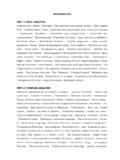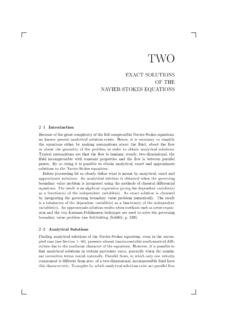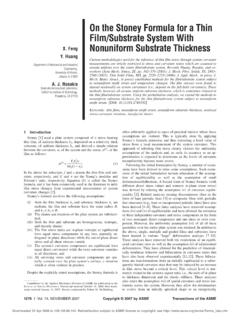Transcription of Unit 60: Dynamics of Machines - FREE STUDY
1 1 unit 60: Dynamics of Machines unit code: H/601/1411 QCF Level:4 Credit value:15 OUTCOME 2 KINEMATICS AND Dynamics TUTORIAL 2 PLANE MECHANISMS 2 Be able to determine the kinetic and dynamic parameters of mechanical systems Cams: radial plate and cylindrical cams; follower types; profiles to give uniform velocity; uniform acceleration and retardation and simple harmonic motion outputs; output characteristics of eccentric circular cams, circular arc cams and cams with circular arc and tangent profiles with flat-faced and roller followers Plane mechanisms: determination of instantaneous output velocity for the slider-crank mechanism, the four-bar linkage and the slotted link and Whitworth quick return motions; construction of velocity vector diagrams.
2 Use of instantaneous centre of rotation Resultant acceleration: centripetal, tangential, radial and Coriolis components of acceleration in plane linkage mechanisms; resultant acceleration and inertia force; use of Klein s construction for the slider crank mechanism Gyroscopic motion: angular velocities of rotation and precession; gyroscopic reaction torque; useful applications gyro-compass and gyro-stabilisers You should judge your progress by completing the self assessment exercises. On completion of this short tutorial you should be able to do the following.
3 Describe a mechanism. Define relative and absolute velocity. Define relative and absolute acceleration. Define radial and tangential velocity. Define radial and tangential acceleration. Describe a four bar chain. Solve the velocity and acceleration of points within a mechanism. Use Klein s construction to find the acceleration of a slider crank mechanism. Use mathematical and graphical methods. Construct velocity and acceleration diagrams. Define the Coriolis Acceleration. Solve problems involving sliding links.
4 It is assumed that the student is already familiar with the following concepts. Vector diagrams. Simple harmonic motion. Angular and linear motion. Inertia force. Appropriate level of mathematics. All these above may be found in the pre-requisite tutorials. D. J. Dunn 2 1. INTRODUCTION A mechanism is used to produce mechanical transformations in a machine . This transformation could be any of the following. It may convert one speed to another speed. It may convert one force to another force.
5 It may convert one torque to another torque. It may convert force into torque. It may convert one angular motion to another angular motion. It may convert angular motion into linear motion. It may convert linear motion into angular motion. A good example is a crank, connecting rod and piston mechanism. Figure 1 If the crank is turned, angular motion is converted into linear motion of the piston and input torque is transformed into force on the piston. If the piston is forced to move, the linear motion is converted into rotary motion and the force into torque.
6 The piston is a sliding joint and this is called PRISMATIC in some fields of engineering such as robotics. The pin joints allow rotation of one part relative to another. These are also called REVOLUTE joints in other areas of engineering. Consider the next mechanism used in shaping Machines and also known as the Whitworth quick-return mechanism. Figure 2 D. J. Dunn 3 The input is connected to a motor turning at constant speed. This makes the rocking arm move back and forth and the head (that carries the cutting tool) reciprocates back and forth.
7 Depending on the lengths of the various parts, the motion of the head can be made to move forwards at a fairly constant cutting speed but the return stroke is quick. Note that the pin and slider must be able to slide in the slot or the mechanism would jam. This causes problems in the solution because of the sliding link and this is covered later under Coriolis acceleration. The main point is that the motion produced is anything but simple harmonic motion and at any time the various parts of the mechanism have a displacement, velocity and acceleration.
8 The acceleration gives rise to inertia forces and this puts stress on the parts in addition to the stress produced by the transmission of power. For example the acceleration of a piston in an internal combustion engine can be enormous and the connecting rod is subjected to high stresses as a result of the inertia as well as due to the power transmission. You will find in these studies that the various parts are referred to as links and it can be shown that all mechanisms are made up of a series of four links.
9 The basic four bar link is shown below. When the input link rotates the output link may for example swing back and forth. Note that the fourth link is the frame of the machine and it is rigid and unable to move. With experience you should be able to identify the four bar chains in a mechanism. All the links shown are rigid links which means they may push or pull. It is possible to have links made of chain or rope which can only pull. Figure 3 D. J. Dunn 4 2. DISPLACEMENT, VELOCITY AND ACCELERATION All parts of a mechanism have displacement, velocity and acceleration.
10 In the tutorial on free vibration, a mechanism called the Scotch Yoke was examined in order to explain sinusoidal or harmonic motion. The wheel turns at a constant speed and the yoke moves up and down. Figure 4 It was shown that the displacement x , velocity v and acceleration a of point p was given as follows. Angle = t Displacement x = R sin( t). Velocity v = dx/dt = R cos( t) Acceleration a = dv/dt = - 2R sin( t) The values can be calculated for any angle or moment of time. The acceleration could then be used to calculate the inertia force needed to accelerate and decelerate the link.


















